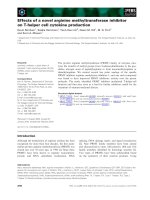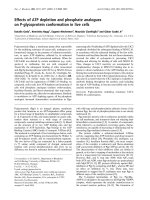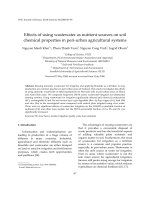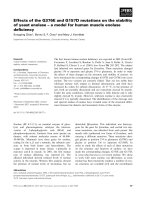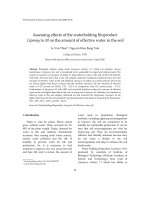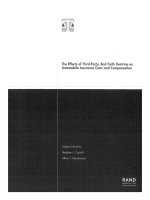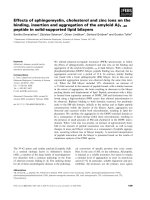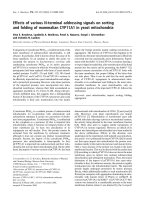Effects of ASEAN free trade area (AFTA) on intra regional trade flows evidence from automotive industry
Bạn đang xem bản rút gọn của tài liệu. Xem và tải ngay bản đầy đủ của tài liệu tại đây (1.22 MB, 76 trang )
VIETNAM NATIONAL UNIVERSITY, HANOI
VIETNAM JAPAN UNIVERSITY
LE MINH PHUONG
EFFECTS OF ASEAN FREE TRADE AREA
(AFTA) ON INTRA-REGIONAL TRADE
FLOWS: EVIDENCE FROM AUTOMOTIVE
INDUSTRY
MASTER'S THESIS
………………….
Master Program in Public Policy
Hanoi, 2020
VIETNAM NATIONAL UNIVERSITY, HANOI
VIETNAM JAPAN UNIVERSITY
LE MINH PHUONG
EFFECTS OF ASEAN FREE TRADE AREA
(AFTA) ON INTRA-REGIONAL TRADE
FLOWS: EVIDENCE FROM AUTOMOTIVE
INDUSTRY
MAJOR: MASTER OF PUBLIC POLICY
CODE: PILOT
RESEARCH SUPERVISOR:
Assistant Prof. TRAN LAM ANH DUONG
Associate Prof. NGUYEN THI MINH
Hanoi, 2020
ACKNOWLEDGEMENTS
The writing of a master’s thesis is not a comfortable task. So far, the biggest
accomplishment in my life is complete it. And, I would like to grab this chance to
express my immense thankfulness to all those persons who gave me their invaluable
support and assistance.
Above all, I am greatly indebted to my supervisors, Assistant Professor Tran Lam Anh
Duong who was very willing with her time and knowledge. She supported me from the
first steps of the research process. Not only instructing, but she also studied with me
from theory to analytical practice. And, Associate Professor Nguyen Thi Minh who
gave me valuable suggestions to help me overcome the most difficult periods. Without
their advice, I would definitely have ended up in chaos.
I would include those who helped me in finding data - Mrs. Nguyen Thi Xuan Thuy
from the Viet Nam Industry Agency (Ministry of Industry and Trade, Vietnam) and Dr.
Dang Quang Vinh from the Master’s program in Public Policy of Viet Nam Japan
University who assisted me during the final procedure.
Especially, I am grateful to all other lecturers Dr. Thuy Anh, Prof. Naohisa Okamoto,
Dr. Vu Hoang Linh who gave me helpful comments during one year of preparation for
the thesis. It is also appropriate to thank, MPP program assistants Ms. Ha and Ms.
Huong and staffs from the Office of Global Initiatives at the University of Tsukuba for
supporting me during two years studying at VJU and to undergo the memorable threemonth internship in Japan.
Last but not least, special thanks are reserved for my family and my friends for their
tireless efforts and spiritual support.
After all, I take full responsibility for any flaws, errors and omissions.
This thesis is dedicated to the memory of my father.
TABLE OF CONTENTS
ACKNOWLEDGEMENTS ..........................................................................................
LIST OF TABLES .........................................................................................................
LIST OF FIGURES ......................................................................................................
LIST OF ABBREVIATIONS .....................................................................................
CHAPTER 1: INTRODUCTION ....................................................................................
1.1
Background ........................................................................
1.1.1
AFTA overview ......................
1.1.2
ASEAN economics and trade
1.1.3
ASEAN automotive industry ..
1.2
Definition .........................................................................
1.3
Research objectives and research questions......................
1.4
Hypotheses .......................................................................
1.5
Method and methodology ................................................
CHAPTER 2: LITERATURE REVIEW.......................................................................
2.1
Theoretical framework of gravity model .........................
2.2
Effects of AFTA on intra-regional trade flows at aggrega
2.3
Effects of AFTA on intra-regional trade at disaggregated
CHAPTER 3: DATA AND METHOD .........................................................................
3.1
The estimation methodology and model specification ....
3.1.1
The estimation methodology .
3.1.2
Model specification ...............
3.3
Data description ................................................................
3.4
The estimation method and common issues of panel dat
estimation ...................................................................................................................
3.5
Data processing ................................................................
CHAPTER 4: FINDINGS .............................................................................................
4.1
Estimation results of trade creation and trade diversion e
4.1.1
Export flows ..........................
4.1.2
Import flows ..........................
4.2
Estimation results of trade creation effect by tariff elimin
4.2.1
Export flows ..........................
4.2.2
Import flows ..........................
4.3
................. .................................................................. .................................................
Trade creation effect by tariff elimination by individual
CHAPTER 5: CONCLUSION.................................................................................... 48
5.1 Research summary............................................................................................. 48
5.2 Policy implication.............................................................................................. 49
5.3 Limitations of the thesis..................................................................................... 50
5.4 Further research.................................................................................................. 50
REFERENCES............................................................................................................ 51
Appendix 1. Average tariff under CEPT Scheme from 1993 to 2015.......................55
Appendix 2. ASEAN Countries code table.............................................................. 57
Appendix 3. Regional trade agreements – AFTA and AFTA-plus-FTAs..................58
Appendix 4. Summary Statistic................................................................................ 59
Appendix 5. The effects of AFTA on export trade flows by PPMLHDFE...............61
Appendix 6. The effects of AFTA on import trade flows by PPMLHDFE...............62
LIST OF TABLES
Table 1.1: Share of total trade on GDP (%) of ASEAN countries, 1993-2018...............3
Table 1.2: ASEAN-5 motor vehicle production (in units), 2006-2018........................... 7
Table 1.3: ASEAN-7 motor vehicle sales (in units), 2006-2018....................................8
Table 1.4: List of ASEAN countries by GDP (PPP) per capita ranked by the World
Bank (2018)................................................................................................................. 13
Table 2.1: The estimated coefficients of AFTA dummies from existing studies…….22
Table 3.1: Possible outcomes of trade effects in an AFTA........................................... 30
Table 3.2: Hypotheses of the estimated coefficients.................................................... 30
Table 3.3: The availability of bilateral trade flows from UN Comtrade....................... 32
Table 3.4: Description of multiple fixed effects models.............................................. 36
Table 4.1: The effects of AFTA on export trade flows by REGHDFE.........................39
Table 4.2: The effects of AFTA on import trade flows by REGHDFE.........................40
Table 4.3: Trade creation effect by tariff elimination – Export flow by PPMLHDFE
method......................................................................................................................... 42
Table 4.4: Trade creation effect by tariff elimination – Import flow by PPMLHDFE
method......................................................................................................................... 43
Table 4.5: Estimation results of trade creation effect by tariff elimination..................44
Table 4.6: Estimation results with country dummy – Export flow............................... 46
Table 4.7: Estimation results with country dummy – Import flow............................... 47
Table 5.1: Summary of trade creation and trade diversion effects...............................48
LIST OF FIGURES
Figure 1.1: Real GDP growth (annual %) of ASEAN region, 1980-2020 ......................
Figure 1.2: Total value of exports and imports of goods and services in ASEAN, 20002017 (in US$ billion) .......................................................................................................
Figure 1.3: Trend of ASEAN total trade, extra-ASEAN trade and intra-ASEAN trade,
1993-2013 ........................................................................................................................ 4
Figure 1.4: Share of export values of goods by intra-ASEAN and its major trading
partners (%), 2000-2017 ..................................................................................................
Figure 1.5: Shares of export and import value of goods by ASEAN country, 2000-2017
(%) ...................................................................................................................................
Figure 1.6: Trend of intra- and extra-ASEAN export of priority integration sector of
automotive products, 1993-2013 .....................................................................................
Figure 1.7: Total automotive export and import value in ASEAN countries, 1993-2018
(in US$ million) ...............................................................................................................
ACFTA
AEC
AFTA
AIFTA
AJCEP
AKFTA
APTA
ASEAN
ATIGA
CBU
CEPT
CIA
CKD
CLMV
EL
FDI
FEM
FTA
GVC
HMR
HS
IL
MFN
MNEs
NTBs
NTMs
Non-Tariff Measures
PPML
Poisson pseudo-maximum likelihood
PPP
Purchasing Power Parity
PTA
Preferential Trade Agreement
SL
Sensitive List
TL
Temporary Exclusion List
REM
Random Effect Model
WDI
World Development Indicators
WTO
World Trade Organization
ZIPPML
Zero-inflated PPML
CHAPTER 1: INTRODUCTION
1.1 Background
1.1.1 AFTA overview
The Association of Southeast Asian Nations (ASEAN) was established in 1967 with 5
original members, namely Indonesia, Malaysia, the Philippines, Singapore and
Thailand. Currently, the association consists of 10 member states, as successively
Brunei Darussalam, Vietnam, Laos, Myanmar (Burma) and Cambodia. In October
2003, ASEAN leaders decided to create a single market for a huge economy of US$722
billion and nearly 550 million people (2003). The building of the ASEAN Economic
Community (AEC) by the end of 2015 is a major milestone of integration effort
attempted in the developing world, offering variety of opportunities for each member
states to attract inward Foreign Direct Investment (FDI) and increase trade flows. AEC
has been considered as successor following the completion of the ASEAN Free Trade
Area (AFTA), which was signed in 1992 in Singapore by 6 original ASEAN countries.
At that time, the AFTA agreement aimed to eliminate the tariff on a wide range of
products between ASEAN members.
The establishment of AFTA has attracted the remaining members, Vietnam has been
joined since 1995, Laos and Myanmar (1997), Cambodia (1999). Under the Common
Effective Preferential Tariff (CEPT) Scheme, the products are firstly classified into two
different groups depending on the willingness of each member - Inclusion List (IL)
and Exclusion List (EL). Those product under IL were subject to removal of tariff to
between 0% and 5% by 2008 for original AFTA members. Later on, the tariff reduction
schedule was revised several times. Finally, the end year of IL was moved to 2002.
The EL was later devided into a Temporary Exclusion List (TL) and Sensitive List
(SL). Those products in TL would be shifted to IL in the future. Whereas, additional
time for both IL and TL were given to the newer member countries, namely Cambodia,
Laos, Myanmar and Vietnam (CLMV) to implement their private routine of tariff
reduction for products which originate from within AFTA members. In addition, nontariff measures (NTMs) or non-tariff barriers (NTBs) were excluded under the CEPT
scheme. However, since 2010 the ASEAN Trade in Goods Agreement (ATIGA) has
come into effect to enhance and supersede the CEPT/AFTA with greater goal
ambiguity covering both tariff and non-tariff elimination.
1
The creation of AFTA (or ATIGA) has generated a bigger internal market that each
member is able to entry into lower trade cost market and attract more investment into
their economy that allow producing on a large scale.
1.1.2 ASEAN economics and trade overview
Nowadays, the ASEAN region has become well known in the world due to its high
real Gross Domestic Product (GDP) growth in a long period of time.
Figure 1.1: Real GDP growth (annual %) of ASEAN region, 1980-2020
Source: IMF DataMapper
Firgue 1.1 illustrates the real GDP growth rate of the ASEAN region compared to the
group of advanced economies and the average across the whole world from 1980 to
2020 (estimated data). ASEAN’s real GDP growth have increased remarkably, except
during two crisis periods: the Asian financial crisis in 1998 and the Global crisis in
2008. The average growth rate of GDP in the whole period 1980-2018 of three groups
ASEAN, advanced economies and the average of the world is 5.3%, 2.2% and 3.3%
respectively. Followed by that data, the average value of this important indicator
reveals that ASEAN is one of the fastest growing economies in the world.
2
On the other hand, trade to GDP ratios measure the relative importance of international
trade in each ASEAN economy. Table 1.1 below shows the trade to GDP ratios or
openness indicator of 10 ASEAN countries. In general, almost ASEAN countries open its
economy to the world, partially due to its economic integration efforts. The high trade
openness which trade to GDP ratios is greater than 100 percent bringing many economic
benefits, from increasing technology transfer, supplying more job, enhancing the total
factor productivity for the economic development. It seems that the smaller economies in
land area and GDP than trade more and vice versa. That can be seen from the table 1.1, for
example Singapore is the most dynamic economy in ASEAN in comparison with
Indonesia which is the largest country in both land area and GDP in ASEAN region.
Table 1.1: Share of total trade on GDP (%) of ASEAN countries, 1993-2018
Singapore
Malaysia
Viet Nam
Cambodia
Thailand
Brunei Darussalam
Lao PDR
Philippines
Indonesia
Myanmar
Source: Author’s calculations based on WITS country profile data
From the calculation formula of GDP by expenditure approach, the rapid of expansion
in GDP of ASEAN region has been definitely contributed by export-import
1
component . The entire value of trade in goods and services in this region has been
playing an important role in GDP measurement under expenditure approach.
By looking at the figure 1.2, the total merchandise trade of ASEAN region has sharply
increased from 2000 to 2017 equivalent to an increase of nearly 3.5 times (ASEAN
Secretariat, 2018).
1 The formula for GDP by expenditure approach: GDP = C + I + G + (X-M)
3
Figure 1.2: Total value of exports and imports of goods and services in ASEAN, 20002017 (in US$ billion)
According to report of ASEAN Secretariat (2014) in the special edition “the removal of
trade barriers has been centered on the removal of intra-ASEAN tariffs through
commitment CEPT under the AFTA”. Although, figures in trade indicates that
“ASEAN depended a great deal on the consumption and production needs of the rest of
the world” (Mahfuz Kabir et al., 2014), but intra-ASEAN trade still has been increased
dramatically, even though faster than overall ASEAN trade and extra-ASEAN trade.
From 1993 to 2013, the intra-ASEAN trade has surged by more than 7 times, while
extra-ASEAN trade has increased more than 5 times.
Figure 1.3: Trend of ASEAN total trade, extra-ASEAN trade and intra-ASEAN trade,
1993-2013
4
Regarding to a very fast increasing in intra-regional trade and the success of trade
surplus in ASEAN region, from 2000 to 2017 intra-ASEAN collectively is the largest
market.
Figure 1.4: Share of export values of goods by intra-ASEAN and its major trading
partners (%), 2000-2017
Overall, there is a significant gap in trade by export and import value among 10
ASEAN countries. Singapore is the largest exporter, followed by Thailand, Malaysia,
Viet Nam, Indonesia and Philippines. Meanwhile, Brunei Darussalam, Laos,
Cambodia and Myanmar are among trade less countries.
Figure 1.5: Shares of export and import value of goods by ASEAN country, 20002017 (%)
5
Specially, according to ASEAN Community in Figure reported in 2014, ASEAN records
a surplus in its trade of agro-based products, rubber-based products, wood-based
products, fisheries products, textile products, electronic products and automotive
products with its major trading partners, although the surplus was relatively small, in
general. According to the report, in the case of automotive products, including both
final and intermediate products, by 2013 ASEAN achieved a small surplus with
Australia and New Zealand, and USA. Meanwhile, trade deficit was large with Japan,
small in the case of China, Republic of Korea, and EU-28.
Figure 1.6: Trend of intra- and extra-ASEAN export of priority integration sector of
automotive products, 1993-2013
1.1.3 ASEAN automotive industry
Regarding to the trade value of automotive industry in ASEAN, this region has
remained a net importer despite its export value is closely catching up with import
value. Remarkably, the value of extra-ASEAN export in the case of automotive was 2
times that of intra-ASEAN export compared to other industries those was 7 to 15 times
(ASEAN Secretariat, 2014). This figures imply that intra-regional trade flows of
automobile are increasingly significant important. However, ASEAN still import
mainly from neighboring ASEAN countries such as China, Japan, South Korea, etc.
Further, according to the ASEAN Investment Report (ASEAN Secretariat, 2020),
steady economic growth, increasing in middle-class consumer, deepening regional
integration ASEAN has attracted more the Multinational Enterprises (MNEs)
increasing their value chain participation in automotive industry.
6
Therefore, AFTA was expected to accelerate easier obtaining and more efficient intraregional and intra-industry trading, creating an environment that is advantageous to
achieve economies of scale in automobiles and its components.
Table 1.2: ASEAN-5 motor vehicle production (in units), 2006-2018
Country
Indonesia
Malaysia
Philippines
Thailand
Viet Nam
Note: Data for other countries are not available
Source: ASEAN Automotive Federation
According to figure collected from the ASEAN Automotive Federation, five largest
economies in producing automobile are Indonesia, Malaysia, Philippines, Thailand, and Viet
Nam produced totally over 44 million units of motor vehicles from 2006 to 2018. Meanwhile,
at the national level, Thailand accounts for 52%, Indonesia (27%), Malaysia (16%), Viet Nam
(4%) and the Philippines (2%). It can be stated that Thailand continues to play a dominant role
in the ASEAN automotive industry. These countries are expected to continue to grow and
become an important role in the global value chain (Kobayashi, 2014).
Korwatanasakul, U., and Intarakumnerd, P. (2020) in the report about the global value
chains in automobiles in ASEAN also emphasized that the automobile industry has
been an important driving force in ASEAN, contributing at least $177 billion to
ASEAN’s GDP every year and creating about 2.4 million jobs.
Overall, ASEAN is considered as an important production hub for the entire
automobile sector, including automobiles, motorcycles, trucks, and their parts
becoming a “factory of Asia”. Therefore, the analysis of trade flows in automotive
industry among ASEAN countries is necessary in this context of trade globalization.
7
Table 1.3: ASEAN-7 motor vehicle sales (in units), 2006-2018
Country
Brunei
Indonesia
Malaysia
Philippines
Singapore
Thailand
Viet Nam
Note: Data for other countries are not available
Source: ASEAN Automotive Federation
During the period 2006-2018, more than 36 million units of motor vehicles have been
sold in the ASEAN market of more than 650 million of population. Indonesia and
Thailand are biggest important markets account for 62% in total, followed by
Malaysia, the Philippines and Viet Nam. Contrarily, sales in Brunei and Singapore is
very lower, even though these two countries are among richest ones. The possible
reason is that because these countries have smaller scale of population.
Figure 1.7: Total automotive export and import value in ASEAN countries, 1993-2018
(in US$ million)
Note: Lack of data for Cambodia, Lao, Myanmar, the Philippines, Viet Nam and Malaysia
8
Source: Author’s collection and calculation from UN Comtrade source
Brunei Darussalam is a small country in land area. Its population is only 428,962
(World Bank) in 2018. From 1990 to 2012, its real GDP has significantly increased
50% before decreasing slowly due to the Global Financial Crisis. Brunei was early
ranked among industrialized countries by high GDP per capita at purchasing power
parity. In 2018 World Bank ranked Brunei as the fifth-richest nation out of 182
countries, based on its petroleum and natural gas fields. Crude oil and natural gas
production of Brunei account for approximately 65% of GDP and 95% of exports, with
Japan as the primary export market. According to Korwatanasakul, U., and
Intarakumnerd, P. (2020), Brunei Darussalam is the only ASEAN country that has not
directly involved in the automotive value chain. However, Brunei was explored
developing assembly plant for electric and renewable energy-powered vehicles in
2016. Besides, the total export value involving automotive industry of this country
from 1993 to 2018 was lowest among ASEAN countries, only 162 million USD.
Cambodia has experienced strong economic growth since 1996. Its GDP grew an
average annual rate of over 8% between 2000 and 2010 and about over 7% since 2011.
Its main industries are tourism, garment, textile, construction and real estate. So far
Cambodia remains one of the poorest countries in the world was ranked at 138
th
measuring by GDP (PPP) per capita, only 4,000 USD for one people per year. Besides,
the total automotive export and import value of Cambodia is also among lowest
countries compared to other ASEAN ones. The automobile industry in Cambodia
mainly engages in Complete Built-Up (CBU) production through Completely Knocked
Down (CKD) kits. Cambodia’s automotive industry still is in its early stages, it could
raise their competitiveness base on advantages of cheap and large labor force in near
future. Typically, this country could have been benefiting from “China-Plus-One” and
“Thailand-Plus-One” strategies, which mainly extended the automobile production of
Tier-2 suppliers in China and Thailand to the CLM countries (Korwatanasakul, U., and
Intarakumnerd, P., 2020).
Lao PDR is the only landlocked country surrounded by Myanmar, China, Viet Nam and
Thailand. Due to its central geographical location, Laos became a hub for overland trade.
Initially, Lao PDR has been one of the memberships of Asia-Pacific Trade Agreement
9
2
(APTA) previously known as the Bankok Agreement was signed in 1975 . Its
population estimates at 7 million people in 2018. As Cambodia, Laos still is poor
th
country ranked at 124 nation according to GDP (PPP) per capita in the world. The
automobile and parts and components industries of the Laos are the least developed
among the CLMV countries. CKD assembly plants have not been established.
However, under the Greater Mekong Sub-region Economic Cooperation and Thailandplus-one strategy, the Lao PDR is one of the key countries for suppling labor at a
relatively low cost for the automotive value chain.
Myanmar (Burma) has been seen as a dynamic economy in the world with the average
annual rate of GDP growth at roughly 9.2% from 1992 to 2018. Its population is about
53.7 million people. Since 2011, Myanmar has experienced a comprehensive reform in
economy and politics Although Myanmar still has lots of challenges to catch up other
countries in ASEAN, this country is expected to receive lots of benefits from its
abundance of cheap and big labor force and natural resources as well.
Thailand is one of early industrialized countries in ASEAN region. Its economy highly
depends on international trade, with exports accounting for 66% of GDP. The main
export sector of this country focus on electronics, agricultural commodities,
automobiles and parts, and processed foods. The country has experienced over the past
50 years developing automotive industry from early 1960s under the regime of import
substitution and a revision of the country’s investment promotion law to attract
automotive assembly to Thailand. Especially, in the late 1980s, due to the appreciation
of the Japanese yen raised the production costs of automobile in Japan. There was a
massive rise in FDI inflows and MNEs contribution to Thailand for both carmakers
st
and parts suppliers. Nowadays, Thailand’s automobile was ranked 1 among ASEAN
rd
th
countries, 3 in the Asian continent and 12 in the world.
Indonesia is the largest economy in the region. This country consists of a thousand islands
and ranked at 4
th
in the world’s population. As an emerging economy Indonesia has
experienced a high economic growth in a long period with the average at 6.8% (19681996) and 5.3% (2000-2018). During the Asian financial crisis, the country’s
2The member of Asia-Pacific Trade Agreement (APTA) include Bangladesh, China, India, Lao PDR,
Mongolia, Republic of Korea, and Sri Lanka.
10
GDP growth decreased dramatically to -13% in 1998. Indonesia is also a huge
domestic market and enable to supply employment for a half of population with the
labor force of more than 125 million people for domestic producing. Besides, a huge
domestic market makes Indonesian automotive manufacturers mainly focus on
producing complete automobiles and export mostly its parts and components to the
world. Japanese producers have contributed significantly to the development of
Indonesia’s automobiles as Thailand.
Malaysia performs impressively in GDP growth from 1963 after gaining independence
from Britain. From 1960s to 2018, tts GDP grew by an average of 6.4% per year. The
economic growth peaked in almost 10 years (1988-1997) with the average of 9.3% per
year just before falling in 1998. Nowadays, Malaysia is an upper middle-income
country with GDP per capita at PPP is above 30,000 US$. Their first national car
project was launched in 1983, which produced a successful car brand for domestic
market. As Thailand, exports and imports in automotive industry of Malaysia have
increasingly contributed to the intra-regional trade flows.
The Philippines is a country which participated early in the auto assembly industry since
1950s. As other ASEAN countries, the motor vehicle industry is principally contributed
and dominated by Japanese automobile manufacturers. However, as of figure of motor
vehicle production, from 2006 to 2018, the Philippines accounts only 2% on the whole
th
total production of ASEAN region, ranked at 5 largest producers. In terms of sales, due
to a small domestic automobile market, more than 2.5 million car units were sold in more
than 10 years accounting for 8%. Since 2007, this country has been increasing its
competitiveness by promoting investment activities inward automobile.
Vietnam’ economy has impressed the intra-regional and extra-regional investors by its
high economic growth and relatively stable politics. In 1989, this country shifted from a
centrally planned to a market. Nowadays, Vietnam is among the most dynamic emerging
countries in Asia in general with the average of annual GDP rate at 6.8% per year from
1989 to 2018. Also, Vietnam entered into production of automobile from early 1990s. In
1995, the first automotive factories were built in this country, knock-down kits to produce
vehicles, starting with Japanese car brand. However, by 2018 Vietnam still is one of the
most protector for domestic manufacturing by high tariffs and non11
tariff barriers level imposing on automotive exporters including from ASEAN. Vietnam is
currently ranked at 4
th
largest automotive manufacturers in the region. The strategy of
development automobile is being viewed as learning from the success of Thailand’s
automobile. Typically, the country is expected to fill the gap with ASEAN’s industrialized
countries through emerging a new player – Vinfast since 2018.
Singapore is a small island city-state located between Malaysia and Indonesia. This
country has only about 5.5 million people (2018). Singapore is a member of numerous
international institutions has led to it being classified as the most open economy in the
world. This country’s economy depends mostly on trade activities such as logistic
service. Singapore has achieved success in linking the existing industries to global and
regional automobile industries and regional markets by its advantage of geographical
location. According to UN Comtrade data, the total automotive export and import
rd
value of Singapore is ranked at 3 in ASEAN region just after Thailand and Indonesia,
which are two largest automotive producers.
Overall, the automobile is a very important industry among manufacturing sectors in
ASEAN that all country would like to have to improve the income level and become
an industrialized country as Thailand, Singapore and Malaysia. In the context of
ASEAN, all ASEAN member states are currently participating in the automobile
global value chain to different degrees. Indonesia and Thailand are regional hubs for
the automobile production bases of global carmakers, while Malaysia occupies a midlevel position. Due to lower technical capacities and limited domestic markets, the
Philippines and Viet Nam focus on completely knocked-down (CKD) assembly and
the production of certain parts and components. The adjustment in the preferential
policies for the automotive industry in Vietnam and Malaysia are expected to further
promote the production and participation in the global and regional supply chains of
the automotive industry. Singapore with existing advantages of preferential tariff and
non-tariff continues to be the wealthiest and the most competitive consumption market
for intra- and extra-regional manufacturers. Cambodia and Myanmar are engaged in
completely built-up (CBU) production through CKD kits, while no automobile
assemblers are observed in the Lao PDR.
12
Table 1.4: List of ASEAN countries by GDP (PPP) per capita ranked by the World
Bank (2018)
Rank
3
5
43
69
97
112
123
124
126
138
Source: World Development Indicators database, International Comparison Program
1.2 Definition
Intra-regional trade
Intra-regional trade defined in this study as the average of intra-AFTA exports and
imports, which focuses on trade exchange between ASEAN member countries.
Automobile industry
This study uses the definition of the automobile industry in global value chain (GVC)
data. The automobile industry is broadly defined as an industry of motorized vehicles
consisting of four wheels and powered by internal engines, while narrowly defined as the
car industry or motor vehicle industry (Dowlah, 2018). In general, the automobile industry
is understood as covering a wide range of motor vehicles, including automobiles (cars),
buses, motorcycles, off-road vehicles, trucks. However, this study focuses on the car
industry and its parts and components industry, therefore the narrow definition is taken
into account. The UN Comtrade Database classifies its traded products according to the
Harmonized Commodity Description and Coding Systems, or
13
Harmonized System (HS). The automobile industry’s imports and exports are
3
classified mainly under sub-headers at HS-4 digit level and HS-6 digit level .
Trade creation and Trade diversion
Trade creation and trade diversion is an economic term as Jacob Viner (1950) firstly
pointed out that related to economic efficiency and welfare-effect definitions.
However, in this study trade creation and trade diversion are different. The study
follows the definitions that were firstly used by Endoh (1999) and applied by
Sattayanuwat and Nantarat (2017) and Wong, C. K. et al. (2017): (1) Trade creation
refers to trade more with non-AFTA member; (2) Trade diversion refers to trade less
with non-AFTA member.
1.3 Research objectives and research questions
In regard to notable achievements in trade liberalization under AFTA and ATIGA that
tariff and non-tariff are eliminated, which have officially been in effect since 1993,
there was a few existing empirical studies conducting research on the impacts of AFTA
on intra-regional trade flows at aggregated data level (Elliott and Ikemoto, 2004; Indira
M. Hapsari and Carlos Mangunsong, 2006; Trung Kien, 2009; Ismail and Wong, C. K.,
2013). Thus, one of disadvantages in using pooled data to investigate the effects of free
trade policy such as AFTA is not enable to reveal the detailed changes in trade volume
of a specific industry. Therefore, it is necessary to apply the gravity model in sector
analysis, especially in the case of the automotive industry in the context of ASEAN
countries’ clear target of becoming industrialized.
Regarding disaggregated level, only Pakasa Bary. (2015) and Wong, C. K. et al. (2017)
used trade data in manufacturing for their analysis. On the other hand, Herath et al. (2014)
implemented a thorough investigation on the ASEAN’s eight agrifood commodities by
applying the gravity model. Meanwhile, Okabe and Urata (2014) conducted a large-scale
examination on almost all ASEAN industries focusing on investigating the trade creation
effect due to tariff reduction . Those studies have focused on the trade creation and trade
diversion effects of AFTA without, however, using an appropriate estimator as explained
later. On the other hand, as mentioned above the
3See in the Appendix
14
ASEAN’s automobile industry has increasingly affirmed its position in the world and
contributed significantly to the intra-regional trade value.
Hence, the purpose of this study is to empirically investigate the effects of ASEAN
Free Trade Area (AFTA) on intra-regional trade flows of automotive industry for the
period of 1993-2018. Moreover, in the context of “openness” of ASEAN countries, the
study also considers the effect of AFTA on non-members. In addition, compared with
previous studies, this study is the only one applying the gravity model and the recent
appropriate techniques to avoid biased estimates in the case of automotive industry in
the context of growing strong regional integrations in ASEAN region.
Based on the main research objective, the principal research questions that the study
attempts to answer are:
1) Whether AFTA has trade creation and trade diversion effects in the case of
automotive industry?
2) Are there any difference in the elasticity of tariff reduction between original
and new AFTA members?
1.4 Hypotheses
Based on the estimated results from existing papers, AFTA has significantly enhanced the
trade flows between members since 1993. Almost the studies showed a trade creation
effect among them. For the case of automotive industry, the study initially believes that
AFTA also has resulted a trade creation effect among AFTA members. With regard to the
increasing trend in trade volumes in ASEAN region, a decreasing export flows would be
occurred from ASEAN automotive exporter to non-ASEAN importer in the world to take
the advantage of the removal of tariff and non-tariff barriers inside the region. In addition,
the significant increasing trend of FDI into ASEAN in recent years contributed to the
export trade value of ASEAN countries and domestic market as well. The trade surplus
recorded in the figure 1.2 suppose that the overall export trade value is greater than import
trade value in a long period of time. That means ASEAN countries have gradually less
depended on import from outside. On the other hand, the level of economic development
and the automotive industry are very different between two groups of countries – original
and new AFTA members – as discussed above (except for
15

